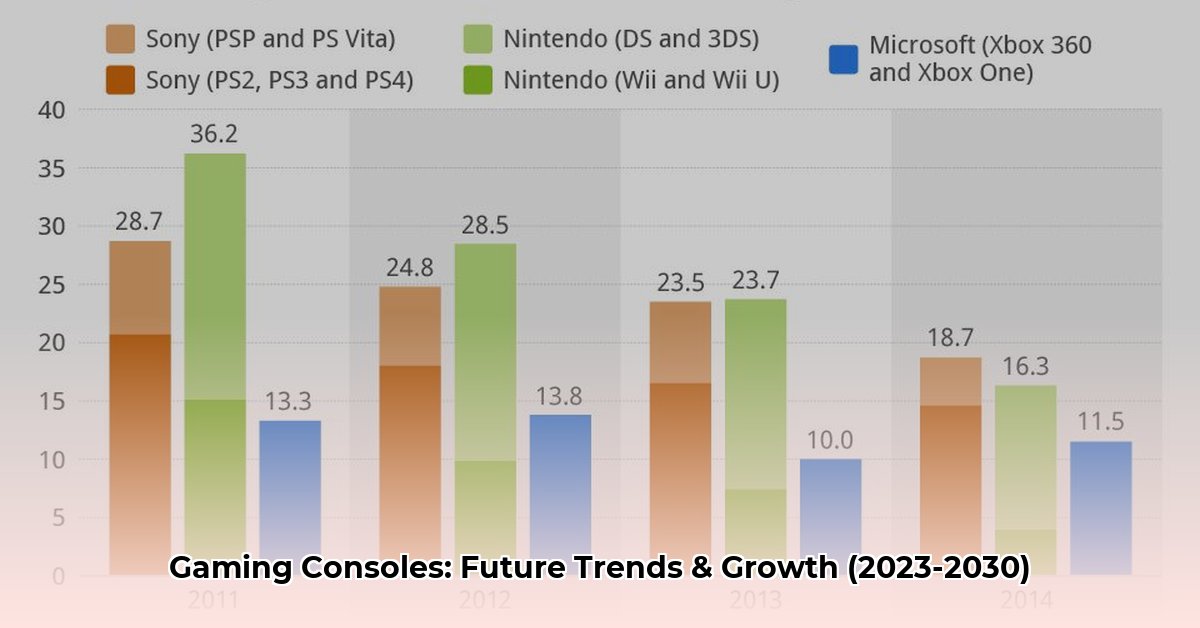Executive Summary
The global gaming console market, valued at $24.36 billion in 2022, is poised for substantial growth, with projections ranging from $59.40 billion to $86.81 billion by 2030. This expansion is fueled by technological advancements, evolving consumer preferences, and the rise of esports. Key players like Sony, Microsoft, and Nintendo continue to dominate, while emerging trends such as cloud gaming, subscription services, and the metaverse promise to reshape the industry landscape. However, challenges such as supply chain disruptions, competition from PC and mobile gaming, and the development costs of advanced hardware require ongoing adaptation and innovation from console manufacturers.
Introduction
The gaming console market encompasses the development, production, distribution, and sale of dedicated video game consoles. This report provides a comprehensive analysis of the current state and future trajectory of this market, exploring key trends, growth drivers, challenges, and the competitive landscape.
Market Size and Growth
The gaming console market witnessed significant growth in recent years, reaching $24.36 billion in 2022. Projections for 2025 suggest a potential surge to $61.32 billion, with further growth anticipated, reaching up to $86.81 billion by 2030. Discrepancies between these projections reflect the inherent uncertainties in forecasting a rapidly evolving market influenced by technological advancements and shifting consumer behaviors.
| Market Size Projections (USD Billions) |
|—|—|
| 2022 | 24.36 |
| 2025 | 61.32 |
| 2030 | 86.81 |
Market Segmentation
The gaming console market can be segmented by various factors:
-
Product Category: This segment includes the various console models offered by different manufacturers (e.g., PlayStation 5, Xbox Series X/S, Nintendo Switch). While Sony currently holds a significant market share, Nintendo is projected to experience substantial growth, possibly due to the success of its hybrid Switch console.
-
Distribution Channel: Online stores command the largest market share, exceeding 45%, while brick-and-mortar retail maintains a steady presence with a projected CAGR of approximately 5%.
-
Hardware Components: This segmentation differentiates between the console itself and peripherals such as controllers, each exhibiting unique growth patterns.
Key Players Analysis
The gaming console market is dominated by key players:
| Company | Current Console(s) | Key Strengths |
|---|---|---|
| Sony | PlayStation 5 (Standard, Digital Edition, Pro) | Powerful hardware, strong exclusive titles |
| Microsoft | Xbox Series X, Xbox Series S | Xbox Game Pass, strong online services |
| Nintendo | Nintendo Switch (Standard, OLED Model, Lite) | Family-friendly, innovative hardware, iconic franchises |
| Valve | Steam Deck | Portability, access to Steam library |
Beyond the “Big Three,” companies like Valve, with its Steam Deck, blur the lines between PC and console gaming. Legacy brands like Atari and Sega also contribute, albeit with different market focuses.
Driving Factors and Challenges
Several factors propel the growth of the gaming console market:
-
Technological Advancements: Enhanced graphics, processing power, and the integration of VR/AR technologies drive demand for more advanced consoles.
-
Esports and Online Gaming: The rise of professional gaming and the increasing popularity of online multiplayer experiences fuel the demand for high-performance hardware.
-
Multimedia Integration: Consoles increasingly serve as entertainment hubs, integrating streaming services and other multimedia functionalities.
However, challenges persist:
-
High Development Costs: Developing cutting-edge consoles requires substantial investment, necessitating high sales volumes to achieve profitability.
-
Supply Chain Disruptions: Global chip shortages and other supply chain issues can hinder production and limit availability.
-
Competition: PC gaming and mobile gaming present significant competition, requiring console manufacturers to continually innovate.
Emerging Trends
Several trends shape the future of gaming consoles:
-
Cloud Gaming: Services like Xbox Cloud Gaming and PlayStation Plus enable game streaming, potentially reducing reliance on expensive hardware.
-
Subscription Services: Game Pass and similar models offer access to vast game libraries for a recurring fee, changing how consumers acquire and experience games.
-
Metaverse, VR/AR: These technologies promise immersive and interactive experiences, though their mainstream adoption and long-term impact remain to be seen.
-
Modular Consoles and Sustainability: The possibility of upgradable consoles and the increasing focus on eco-friendly manufacturing are also gaining traction.
-
AI Enhancement: AI is expected to play a greater role in personalizing gameplay, creating dynamic difficulty and more realistic NPCs.
Regional Analysis
The Asia Pacific region currently accounts for the largest share of the gaming console market revenue, exceeding 45%. North America, with the U.S. as a primary driver, holds a substantial market share and is projected to experience robust growth, with a CAGR of approximately 9% between 2023 and 2030. This growth suggests North America’s high disposable income and strong gaming culture.
Future Outlook
The gaming console market’s future is dynamic and promising, yet uncertain. Cloud gaming, subscription services, and immersive technologies like VR/AR have the potential to revolutionize the industry. The ongoing evolution of the metaverse adds another layer of complexity and opportunity. The success of various players will likely depend on their ability to adapt to these trends and meet evolving consumer demands.
Conclusion
The gaming console market is experiencing significant transformation. While established players maintain their dominance, emerging technologies and evolving consumer preferences create both opportunities and challenges. The market’s trajectory suggests continued growth, albeit with inherent uncertainties. The ability to innovate, adapt, and address emerging trends will likely determine the future success of console manufacturers and the overall shape of the gaming landscape.







